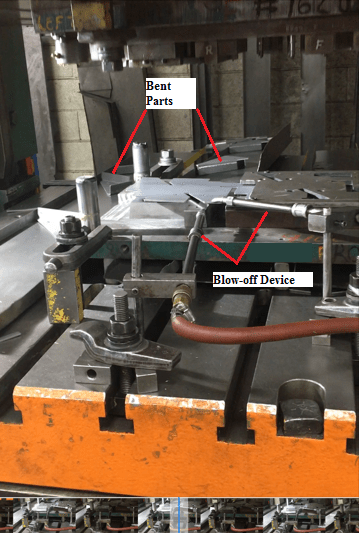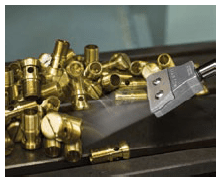A stamping company contacted me for help in their ejection blow-off system. Their operation consisted of a punch press that would form two 8” X 8” triangles from a square piece of metal. The operation of the punch press was to cut the square piece diagonally at the same time forming the outside edges of the triangle. At the end of each stroke cycle, the formed parts would then be blown off the die with compressed air. The blow-off system consisted of two pipes, one that was a ¾” NPT pipe and the other that was a ½” NPT pipe. They both had the ends of a long nipple flattened to concentrate the air flow. EXAIR has reduced air use, saved money, and lowered noise levels for many similar applications by replacing open blow-off devices with our engineered air nozzles.
In giving me more details about their operation, the system had a timing sequence that controlled an actuator. When the cycle was complete, the actuator, located below the tabletop of the punch press, would open and send compressed air through both pipes. The positions of the blow-off pipes were designed to eject one part off the side of the die and the other part off the front of the die into a collection chute. (Reference the picture below) They were having issues when their blow-off system wasn’t consistently able to eject the 1 lb. part completely off the die. In manually having to remove the parts, it would cause an unsafe environment as well as a slowdown in operations. They found that EXAIR manufactures Intelligent Compressed Air Products and wondered if we could help.

With a lack of restriction at the end of the pipe, the air pressure will drop quickly as it travels through a relatively long length of pipe. The actuator, which was more than 3 feet away from the end of the pipes, had a line pressure of 90 psig (maximum that they could supply). By the time the compressed air reached the ejection site, the pressure was much lower; thus, not quite removing the part from the die. An example that I like to use is a garden hose attached to a spigot outside your house. As you open the spigot, water will flow out of the hose at a slow velocity; not very strong, that is the same as air through an open pipe. When you place your thumb partially over the end of a garden hose you restrict the flow and increase velocity. Engineered nozzles from EXAIR work the same way. They restrict the flow at the nozzle, increasing the pressure for a more effective velocity and blow-off force. Neal Raker wrote a great blog for EXAIR referencing how the nozzles work; called “What’s in a Nozzle?”

I recommended the model HP1125, 2” High Power Flat Super Air Nozzle. It has a 2” wide air stream to allow more contact against the side of the triangle edge. It has a force of 2.2 lbs. at 80 psig which is more than enough to eject the 1 lb. formed part. As an added benefit, it only has a noise level of 83 dBA which is magnitudes more quiet than the open pipe. Also in using the engineered nozzles, they were able to use much less compressed air in their blow-off, saving them over $1,000/year. If you find that your open pipe blow-off is too loud, not effective, or uses way too much compressed air, you should contact an Application Engineer to see which engineered nozzle would best suit your application.
John Ball
Application Engineer
Email: johnball@exair.com
Twitter: @EXAIR_jb